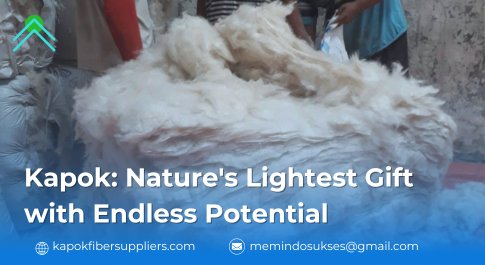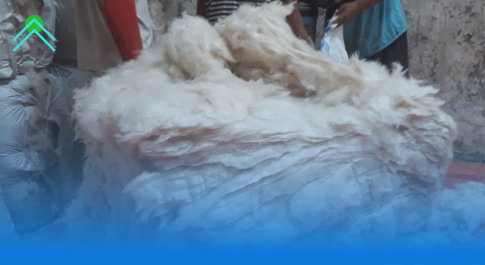
Kapok: Nature’s Lightest Gift with Endless Potential
In the lush, tropical rainforests where the towering Ceiba trees reach for the sky, a quiet wonder is growing: kapok. This remarkable fiber, which has been used for centuries, is nature’s answer to a variety of modern needs. Light, buoyant, and versatile, kapok offers a sustainable alternative to many materials we take for granted today. Whether you’ve heard of it or not, this natural fiber is making a comeback in eco-conscious circles, and for good reason.
What Exactly is Kapok?
Kapok is a fibrous material derived from the seeds of the Ceiba pentandra, a large tree that grows in tropical climates across Africa, Asia, and Latin America. The seeds of this tree are encased in large, pod-like fruits that burst open when ripe, releasing thousands of fluffy fibers. These fibers are soft, light, and filled with air, which makes them incredibly buoyant.
Once harvested, kapok fibers can be processed and used in a wide array of applications, from stuffing for pillows and mattresses to insulation in outerwear. Due to its airy structure, kapok is sometimes called the “cotton of the tropics,” but unlike cotton, it has properties that make it unique and even more valuable in certain contexts.
A Renewable, Eco-Friendly Alternative
One of the most exciting aspects of kapok is its environmental impact—or lack thereof. In a world increasingly focused on reducing reliance on synthetic materials and fostering sustainable practices, kapok is a shining example of a renewable resource that can meet a variety of human needs without depleting the earth.
Kapok fibers are 100% natural and biodegradable, unlike the petroleum-based synthetics that are commonly used today. This means that products made from kapok, such as pillows, cushions, or insulation, will break down naturally at the end of their life cycle, avoiding the environmental burden of non-biodegradable plastics or foams.
Moreover, the kapok tree itself is a powerhouse of ecological benefit. It helps maintain biodiversity in rainforests, provides shelter for countless species of plants and animals, and plays a critical role in preventing soil erosion. By choosing products made from kapok, we not only support the responsible use of natural resources but also help protect the rainforests and the communities that rely on them.
History of Kapok: From Traditional Use to Modern Innovation
The use of kapok dates back to ancient civilizations, where it was treasured for its lightness and buoyancy. In Southeast Asia, it was traditionally used to fill bedding and cushions, while in other parts of the world, kapok fibers were woven into textiles or used as insulation in boats and floating devices.
During the 20th century, kapok became an essential material for life jackets, due to its remarkable ability to float. However, as synthetic alternatives such as foam became more widely available, the use of kapok in life-saving equipment declined. Yet, despite being overshadowed by modern innovations, kapok still has a place in our world.
In fact, it’s undergoing a revival in eco-conscious markets, as people become more aware of the environmental toll of synthetic materials. Today, kapok is finding new life in a range of products, from sustainable furniture to eco-friendly clothing.
Modern Uses of Kapok: Embracing a Greener Future
Kapok may be an ancient material, but it has a modern, sustainable twist. Some of the innovative uses of kapok today include:
- Sustainable Bedding and Mattresses
Kapok is a natural alternative to synthetic foams commonly found in mattresses and pillows. Its lightness, combined with its ability to regulate temperature and wick away moisture, makes it an excellent choice for bedding that is both comfortable and eco-friendly. Many mattress companies are now offering kapok-filled options, allowing consumers to sleep soundly knowing their bed is not contributing to environmental harm. - Eco-Friendly Insulation
Thanks to its exceptional insulating properties, kapok is being used in outdoor gear such as jackets, sleeping bags, and gloves. Kapok is lighter than synthetic alternatives and retains warmth while allowing for breathability. These natural insulation products help reduce reliance on synthetic, often petroleum-based, insulation materials. - Sustainable Upholstery
Kapok has found a place in the world of interior design as a stuffing material for cushions and furniture. By replacing polyester fibers or polyurethane foam with kapok, companies are reducing the environmental impact of furniture production. Kapok-filled cushions are not only environmentally friendly but are also hypoallergenic, making them a great option for people with sensitivities. - Handcrafted Goods
Artisans and crafters have long utilized kapok for making soft toys, dolls, and decorative items. Its soft texture and hypoallergenic properties make it ideal for handmade, natural products. As consumers look for more sustainable, handcrafted alternatives, kapok provides a perfect solution for eco-friendly crafting.
The Challenges of Kapok
Despite its many benefits, kapok does face some challenges, primarily related to harvesting and processing. Unlike cotton, which can be mechanically harvested, kapok requires careful, manual picking, which can be labor-intensive and time-consuming. This adds to the cost of production and can limit the widespread availability of kapok products.
Additionally, although kapok trees are widely distributed in tropical regions, the large-scale cultivation and harvesting of the fiber still need to be developed in a way that supports sustainable farming practices. With the right technologies and management strategies, however, kapok has the potential to be a major player in the movement toward sustainable materials.
A Natural Future with Kapok
As we continue to look for ways to live more sustainably, kapok is proving to be a valuable resource with a future full of promise. Its lightness, buoyancy, and eco-friendly properties make it a perfect alternative to synthetic materials in a variety of industries, from textiles to construction. By investing in kapok-based products, we not only reduce our carbon footprint but also support ethical, environmentally responsible industries.
In the end, kapok is more than just a fiber. It’s a symbol of what nature can offer when we pay attention to its gifts. From its historical roots as a flotation device to its modern-day applications as an eco-friendly material, kapok reminds us that innovation doesn’t have to come at the cost of the planet—it can be in harmony with it.
So the next time you reach for an item made from sustainable materials, consider kapok. It’s light, it’s soft, and it’s a little piece of nature’s ingenuity, ready to help us create a greener, more balanced world.
Contact us :
☎️ : +6285933133244
📍 : Jl.Ir Soekarno, No.122, Dadaprejo, Junrejo, Kota Batu, East Java 65323

